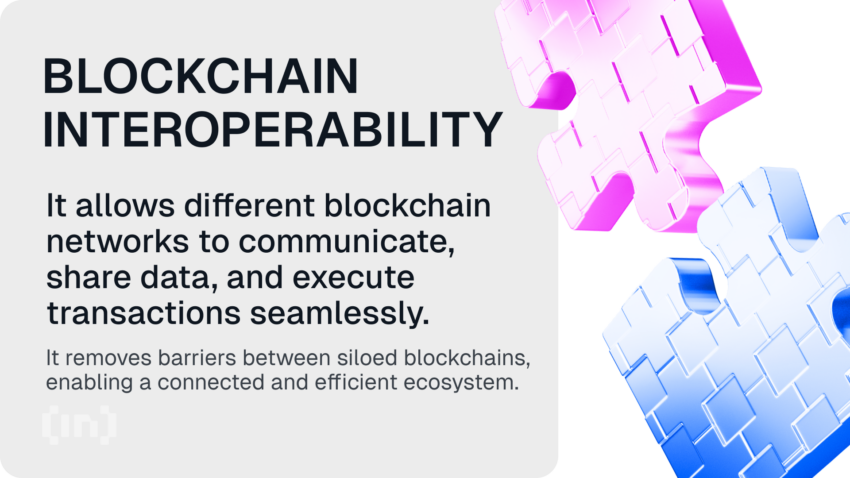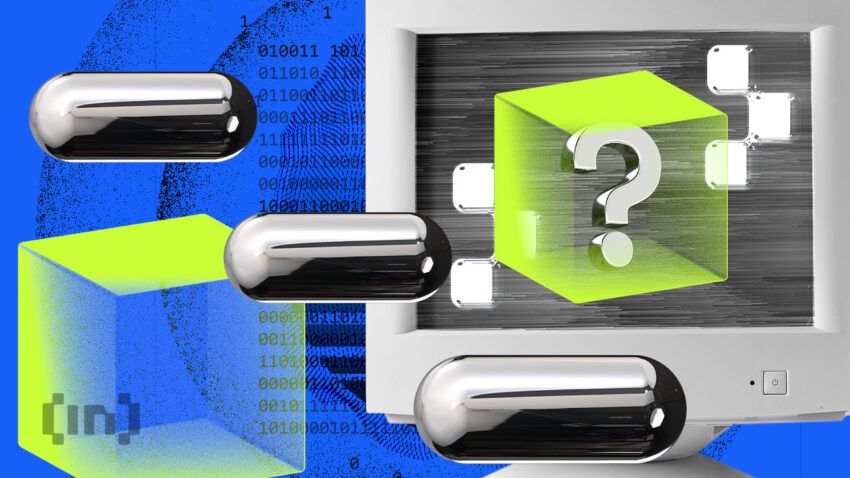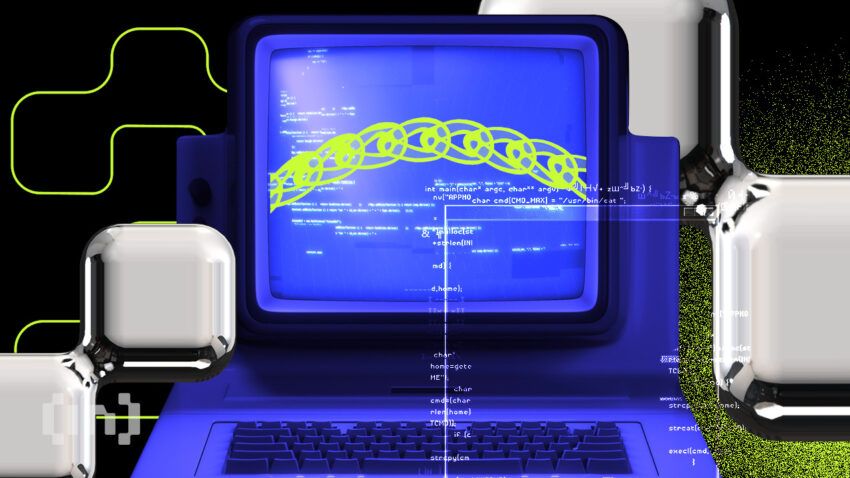As the number of blockchains continues to grow, the subject of blockchain interoperability is becoming increasingly prominent. This guide will detail several interoperable blockchain projects and explain why the concept is so important in 2025.
KEY TAKEAWAYS
➤ Blockchain interoperability allows seamless data and asset transfers across chains.
➤ Token bridges, oracles, and atomic swaps enable cross-chain communication.
➤ Polkadot, Cosmos, and Wanchain are key projects for interoperability.
What is blockchain interoperability?

Blockchain interoperability refers to blockchains’ ability to communicate and facilitate seamless data and crypto asset transfers. The concept aims to make it possible for web3 users to switch from one blockchain network to another seamlessly.
Interoperability also encompasses blockchains’ ability to communicate with traditional web2 systems in the off-chain environment.
Cross-chain messaging protocols allow blockchain networks to communicate with each other. These protocols also support the development of decentralized applications (DApps) that can work across different chains.
Did you know? Cross-chain messaging protocols, such as Polkadot’s XCM or Cosmos’ IBC (Inter-Blockchain Communication) enable interoperability between different blockchains. These protocols allow assets, data, and commands to move freely between chains, helping the development of complex multi-chain applications. As a result, they not only reduce fragmentation but also enhance the user experience by creating a more interconnected blockchain ecosystem.
Why is blockchain interoperability important?
The importance of blockchain interoperability is growing as more and more industries adopt blockchain technology.
Unfortunately, the way developers have typically built layer-1 blockchains isn’t sustainable in the long term since they are limited in their scope of use. This could also stifle progress in the blockchain sector. Thus, to get more out of blockchain technology, interoperability is essential. It will also increase flexibility, enabling developers to create cross-chain decentralized applications (DApps).
An interoperable on-chain environment can enable the co-existence of both public and private blockchains, allowing them to share data with one another easily. Moreover, new products and services that leverage interoperability across several blockchain networks can emerge.
How is blockchain interoperability achieved?

Many of the layer-1 blockchains in existence today were built in isolation. Therefore, they do not have built-in features to enable interoperability. Fortunately, numerous solutions have emerged, enabling layer-1 blockchains to achieve interoperability. These blockchain interoperability solutions include the following.
Oracles
Oracles permit blockchain networks to engage with off-chain data, allowing smart contracts to execute based on data from the real world. That makes oracles essential since smart contracts require real-world data stored in external systems to execute different use cases. For instance, a deed transfer on the blockchain may need information about the property outside any on-chain environment. Therefore, an oracle will act as a bridge between the on-chain world and off-chain legacy systems.
When choosing blockchain oracles for their networks, projects may consider using decentralized oracles instead of centralized ones. Decentralized oracles protect data integrity by avoiding a single point of failure and data manipulation. For example, Chainlink’s decentralized oracle network is a popular solution in the crypto sector. Its users include projects like Aave, Synthetix, Compound, Crypto.com, or Kyber Network.
Token bridges
Token bridges permit users to move assets from one blockchain network to another. The process of doing this will vary from bridge to bridge. For example, some bridges may use the lock and mint mechanism. In this process, a smart contract locks a crypto asset in a source chain while a different smart contract mints a cloned version of this asset on a destination network.
Recent developments:
LayerZero, a prominent omnichain interoperability protocol, has seen rapid growth in adoption. It enables seamless transfers of both assets and messages across multiple chains, without relying on wrapped tokens. This approach to interoperability is gaining traction due to its potential to reduce the risks associated with bridges, such as hacks and liquidity drain. Additionally, Multichain, another well-known cross-chain bridge provider, has expanded its supported blockchains to over 30 networks, making it one of the most comprehensive solutions in the market.
Other bridges may operate by burning tokens on the source chain and then minting the same tokens on the destination chain. Moreover, a different type of token bridge locks tokens on the source chain and then unlocks them from a liquidity pool on the destination chain. A liquidity pool is a collection of crypto assets held in a smart contract. Token bridges that use this mechanism encourage people to provide liquidity on both sides of the bridge by creating incentive schemes like revenue sharing.
Importantly, as of today, tokens created on a destination chain are referred to as wrapped assets in most token bridges.
Atomic swaps
Atomic swap protocols permit users to exchange tokens across chains. That means they can trade a token on one blockchain and get a different token on another chain. Atomic swaps use smart contracts to enable cross-chain token swapping.
Sidechains
Sidechains are independent blockchains that connect to a parent blockchain through a two-way bridge. Projects build sidechains to help scale the parent chain. To illustrate, Polygon is a sidechain that seeks to scale Ethereum by improving its transaction throughput.
Although sidechains have a connection to the parent blockchain, they use separate consensus algorithms and have different native tokens. Their project roadmaps and history are also distinct from the mainchain, hence their independence.
Native payments
Native payments occur when an application on one blockchain triggers a payment in a different blockchain in its native token. Payments across blockchains may rely on blockchain data. Case in point: payments can occur on one blockchain based on data from another chain.
Smart contract calls
Smart contract calls refer to a smart contract on one chain calling a smart contract function on another blockchain. This solution enables token bridging and swapping.
Blockchain interoperability protocols
Blockchain interoperability protocols are blockchains that focus on cross-chain interoperability. Unlike distinct blockchains that operate in isolation, interoperability protocols aim to bring together multiple blockchains that can interact seamlessly with one another. These protocols also make independent, siloed chains interoperable.
Advantages and disadvantages of blockchain interoperability
Blockchain interoperability has its share of pros and cons. You might be surprised by the benefits and challenges it brings to the table.
| Advantages | Disadvantages |
| Seamless data sharing: Enables smooth data sharing across public and private blockchains. | Security risks: Transferring data or assets from a less secure chain to a more secure one can expose the latter to vulnerabilities. |
| Collaboration: Promotes collaboration between companies by allowing interoperable blockchains to communicate. | Varying transaction throughputs: Chains with lower throughput may be overwhelmed by transactions from chains with higher speeds. |
| Decentralization: Fosters decentralization by creating a connected network of chains instead of a few siloed chains dominating the market. | Compatibility issues: It’s easier to connect blockchains that are compatible (e.g., EVM chains) than those that aren’t, requiring more effort for non-EVM chains. |
| Innovation growth: Allows innovation to expand beyond a single chain, accelerating growth in the crypto ecosystem. | Trust and consensus variations: Not all blockchains have the same level of trust or consensus mechanisms, creating additional barriers to interoperability. |
| Free movement of value: Enables users to move value freely across interconnected chains, enhancing trade and economic activity. |
Top interoperable blockchain projects
1. Polkadot
Polkadot is a blockchain built with interoperability in mind. It brings together an ecosystem of private and public blockchains (parachains), enabling them to communicate. Non-blockchain systems can also become parachains under certain conditions.
Parachains are hosted on Polkadot. This works because chains plug into a connectivity layer (called the Polkadot Relay chain), where they use Polkadot’s pooled security system to confirm transactions. Independent blockchains like Bitcoin can still enjoy the interoperability of Polkadot through bridges.
Ethereum’s co-founder, Gavin Wood, is the founder of Polkadot. Other founders include Robert Habermeier and Peter Czaban. The Polkadot network launched in May 2020.
Did you know? Polkadot’s parachain auctions are a unique way for projects to secure a slot on the network. These auctions allow projects to bid for a limited number of slots, and winning projects can operate as parachains for a fixed period, enhancing the network’s scalability.
2. Cosmos
Cosmos, which calls itself the internet of blockchains, is a network of blockchains (called zones) connected through the Cosmos Hub and a communication layer called the inter-blockchain communication protocol (IBC). These blockchains can communicate with each other, enabling users to transfer value from one chain to another. The Cosmos Hub monitors the state of all blockchains in the network.
Cosmos released its whitepaper in 2016 and held a token sale in 2017. Its founders are Zarko Milosevic, Jae Kwon, and Ethan Buchman. Tendermint was originally the network’s core contributor. Today, Cosmos receives support from the Interchain Foundation.
Recent development:
Cosmos has expanded its IBC protocol to support NFT transfers between different chains, enabling cross-chain NFT marketplaces to thrive. This development has positioned Cosmos as a leading player in the cross-chain NFT space.
3. Wanchain
Wanchain is a blockchain that introduces interoperability through decentralized bridges that connect siloed blockchain networks. The Wanchain project aims to build an interoperable web3 ecosystem where all blockchains can communicate with each other, including EVM-compatible blockchains and their non-EVM counterparts. In 2021, Wanchain built a direct, decentralized bridge between Bitcoin and Ethereum, making them interoperable.
The network provides three types of bridges: direct, NFT, and layer-2. These bridges rely on the support of bridge nodes (also known as storeman nodes). Wanchain requires at least 25 bridge nodes to be active at any given time. Jack Lu established Wanchain in 2017.
Blockchain interoperability is crucial to web3
Blockchain interoperability is essential to the development of web3. Developers must be more intentional about creating interoperable blockchains going forward. This will prevent third-party service providers from coming in with centralized interoperability solutions to connect blockchains. In the coming years, we could see more interoperable blockchains emerge as the demand for cross-chain value transfer rises.
Frequently asked questions
Which blockchains have interoperability?
What is a blockchain interoperability example?
Which is the top interoperability blockchain?
Why are blockchains not interoperable?
Disclaimer
In line with the Trust Project guidelines, the educational content on this website is offered in good faith and for general information purposes only. BeInCrypto prioritizes providing high-quality information, taking the time to research and create informative content for readers. While partners may reward the company with commissions for placements in articles, these commissions do not influence the unbiased, honest, and helpful content creation process. Any action taken by the reader based on this information is strictly at their own risk. Please note that our Terms and Conditions, Privacy Policy, and Disclaimers have been updated.




